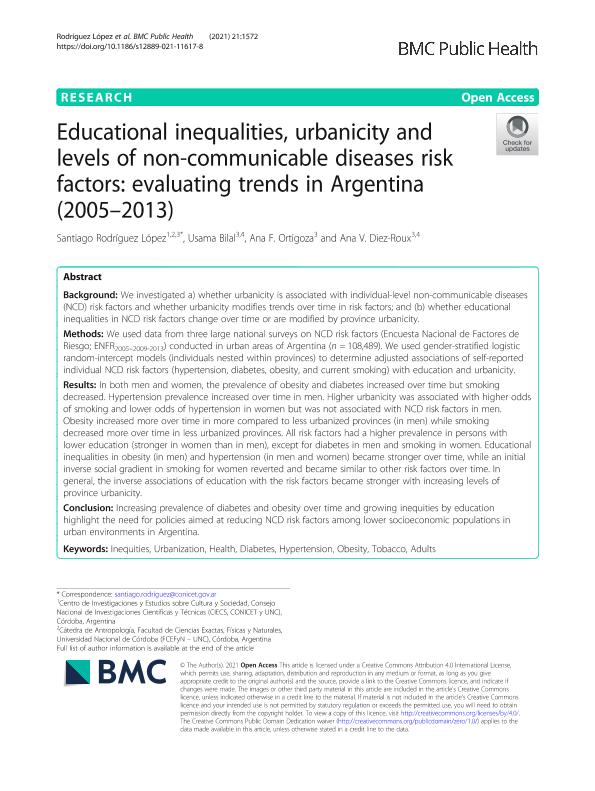Artículo
Educational inequalities, urbanicity and levels of non-communicable diseases risk factors: evaluating trends in Argentina (2005–2013)
Fecha de publicación:
08/2021
Editorial:
BioMed Central
Revista:
BMC Public Health
ISSN:
1471-2458
Idioma:
Inglés
Tipo de recurso:
Artículo publicado
Clasificación temática:
Resumen
Background: We investigated a) whether urbanicity is associated with individual-level non-communicable diseases (NCD) risk factors and whether urbanicity modifies trends over time in risk factors; and (b) whether educational inequalities in NCD risk factors change over time or are modified by province urbanicity. Methods: We used data from three large national surveys on NCD risk factors (Encuesta Nacional de Factores de Riesgo; ENFR2005–2009-2013) conducted in urban areas of Argentina (n = 108,489). We used gender-stratified logistic random-intercept models (individuals nested within provinces) to determine adjusted associations of self-reported individual NCD risk factors (hypertension, diabetes, obesity, and current smoking) with education and urbanicity. Results: In both men and women, the prevalence of obesity and diabetes increased over time but smoking decreased. Hypertension prevalence increased over time in men. Higher urbanicity was associated with higher odds of smoking and lower odds of hypertension in women but was not associated with NCD risk factors in men. Obesity increased more over time in more compared to less urbanized provinces (in men) while smoking decreased more over time in less urbanized provinces. All risk factors had a higher prevalence in persons with lower education (stronger in women than in men), except for diabetes in men and smoking in women. Educational inequalities in obesity (in men) and hypertension (in men and women) became stronger over time, while an initial inverse social gradient in smoking for women reverted and became similar to other risk factors over time. In general, the inverse associations of education with the risk factors became stronger with increasing levels of province urbanicity. Conclusion: Increasing prevalence of diabetes and obesity over time and growing inequities by education highlight the need for policies aimed at reducing NCD risk factors among lower socioeconomic populations in urban environments in Argentina.
Palabras clave:
INEQUITIES
,
URBANIZATION
,
HEALTH
,
DIABETES
,
HYPERTENSION
,
OBESITY
,
TOBACCO
,
ADULTS
Archivos asociados
Licencia
Identificadores
Colecciones
Articulos(CIECS)
Articulos de CENTRO DE INVESTIGACIONES Y ESTUDIO SOBRE CULTURA Y SOCIEDAD
Articulos de CENTRO DE INVESTIGACIONES Y ESTUDIO SOBRE CULTURA Y SOCIEDAD
Citación
Rodríguez López, Santiago; Bilal, Usama; Ortigoza, Ana F.; Diez Roux, Ana Victoria; Educational inequalities, urbanicity and levels of non-communicable diseases risk factors: evaluating trends in Argentina (2005–2013); BioMed Central; BMC Public Health; 21; 1; 8-2021; 1-12
Compartir
Altmétricas




